spare wheel HONDA CIVIC HYBRID 2012 9.G Owners Manual
[x] Cancel search | Manufacturer: HONDA, Model Year: 2012, Model line: CIVIC HYBRID, Model: HONDA CIVIC HYBRID 2012 9.GPages: 313, PDF Size: 8.65 MB
Page 255 of 313
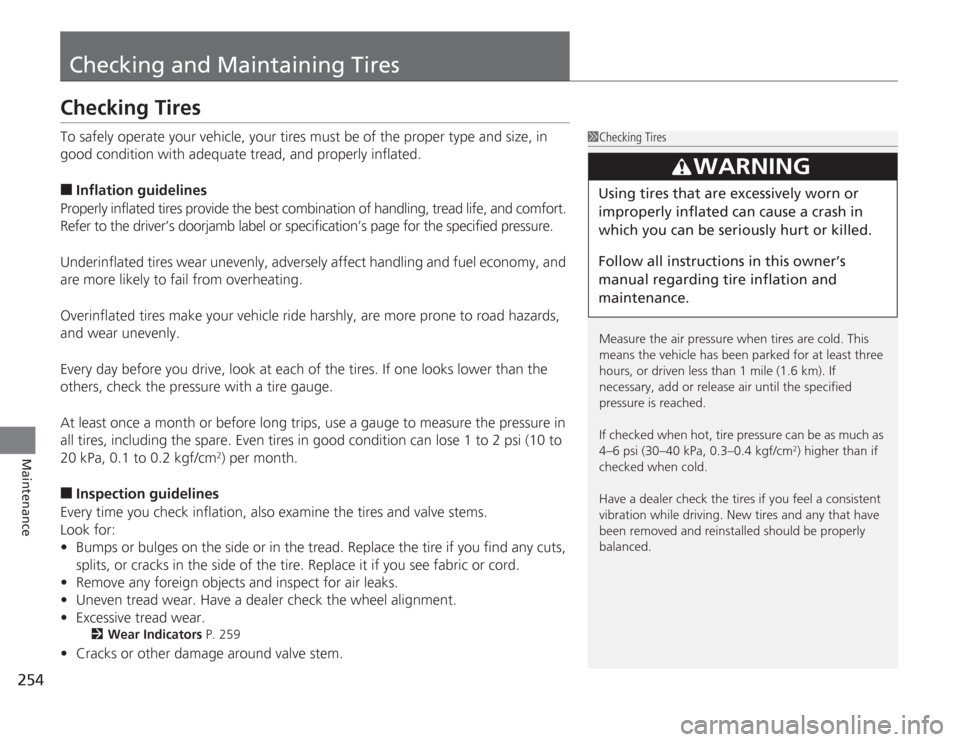
254Maintenance
Checking and Maintaining TiresChecking TiresTo safely operate your vehicle, your tires must be of the proper type and size, in
good condition with adequate tread, and properly inflated.■
Inflation guidelines
Properly inflated tires provide the best combination of handling, tread life, and comfort.
Refer to the driver’s doorjamb label or sp ecification’s page for the specified pressure.
Underinflated tires wear unevenly, adversely affect handling and fuel economy, and
are more likely to fail from overheating.
Overinflated tires make your vehicle ride harshly, are more prone to road hazards,
and wear unevenly.
Every day before you drive, look at each of the tires. If one looks lower than the
others, check the pressure with a tire gauge.
At least once a month or before long trips, use a gauge to measure the pressure in
all tires, including the spare. Even tires in good condition can lose 1 to 2 psi (10 to
20 kPa, 0.1 to 0.2 kgf/cm
2) per month.
■
Inspection guidelines
Every time you check inflation, also examine the tires and valve stems.
Look for:
• Bumps or bulges on the side or in the tread. Replace the tire if you find any cuts,
splits, or cracks in the side of the tire. Re place it if you see fabric or cord.
• Remove any foreign objects and inspect for air leaks.
• Uneven tread wear. Have a dealer check the wheel alignment.
• Excessive tread wear.
2 Wear Indicators P. 259
•Cracks or other damage around valve stem.
1Checking Tires
Measure the air pressure when tires are cold. This
means the vehicle has been par ked for at least three
hours, or driven less than 1 mile (1.6 km). If
necessary, add or release air until the specified
pressure is reached.
If checked when hot, tire pressure can be as much as
4–6 psi (30–40 kPa, 0.3–0.4 kgf/cm
2) higher than if
checked when cold.
Have a dealer check the tires if you feel a consistent
vibration while driving. New tires and any that have
been removed and reinstalled should be properly
balanced.
3
WARNING
Using tires that are excessively worn or
improperly inflated can cause a crash in
which you can be seri ously hurt or killed.
Follow all instruc tions in this owner’s
manual regarding tire inflation and
maintenance.
Page 274 of 313

273
Continued
Handling the Unexpected
If a Tire Goes FlatChanging a Flat TireIf a tire goes flat while driving, grasp the steering wheel firmly, and brake gradually
to reduce speed. Then, stop in a safe place. Replace the flat tire with a compact
spare tire. Go to a dealer as soon as possible to have the full size tire repaired or
replaced.
1.Park the vehicle on firm, level, and non-slippery ground.
2. Put the shift lever in
(P
.
3. Set the parking brake.
4. Turn on the hazard warning lights and turn the ignition switch to LOCK
(0
.
1Changing a Flat Tire
Follow compact spare precautions:
Periodically check the tire pressure of the compact
spare. It should be set to the specified pressure.
Specified Pressure: 60 psi (420 kPa, 4.2 kgf/cm
2)
When driving with the compact spare tire, keep the
vehicle speed under 50 mph (80 km/h). Replace with
a full size tire as soon as possible.
The compact spare tire and wheel in your vehicle are
specifically for this model.
Do not use them with another vehicle.
Do not use another type of compact spare tire or
wheel with your vehicle.
Do not mount tire chains on a compact spare tire.
If a chain-mounted front tire goes flat, remove one of
the full-size rear tires and replace it with the compact
spare tire. Remove the flat front tire and replace it
with the full size tire that was removed from the rear.
Mount the tire chains on the front tire.
Do not use a puncture-repairing agent on a flat tire,
as it can damage the tire pressure sensor.
U.S. models only
Page 275 of 313
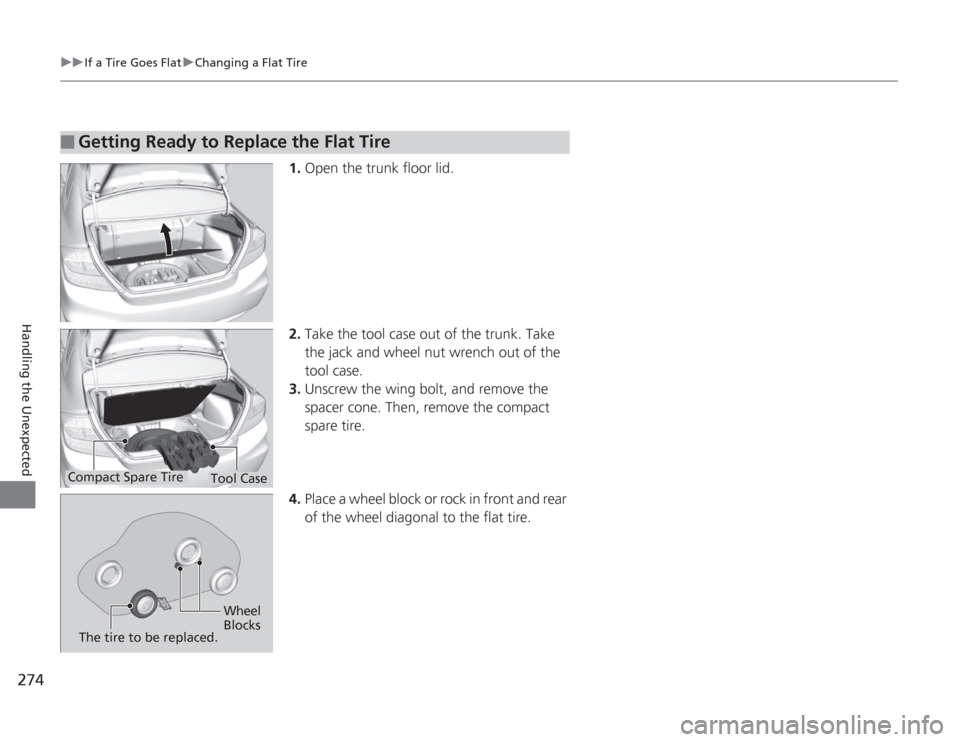
274
uuIf a Tire Goes Flat uChanging a Flat Tire
Handling the Unexpected
1. Open the trunk floor lid.
2. Take the tool case out of the trunk. Take
the jack and wheel nut wrench out of the
tool case.
3. Unscrew the wing bolt, and remove the
spacer cone. Then, remove the compact
spare tire.
4. Place a wheel block or rock in front and rear
of the wheel diagonal to the flat tire.
■
Getting Ready to Replace the Flat Tire
Tool Case
Compact Spare Tire
Wheel
Blocks
The tire to be replaced.
Page 276 of 313
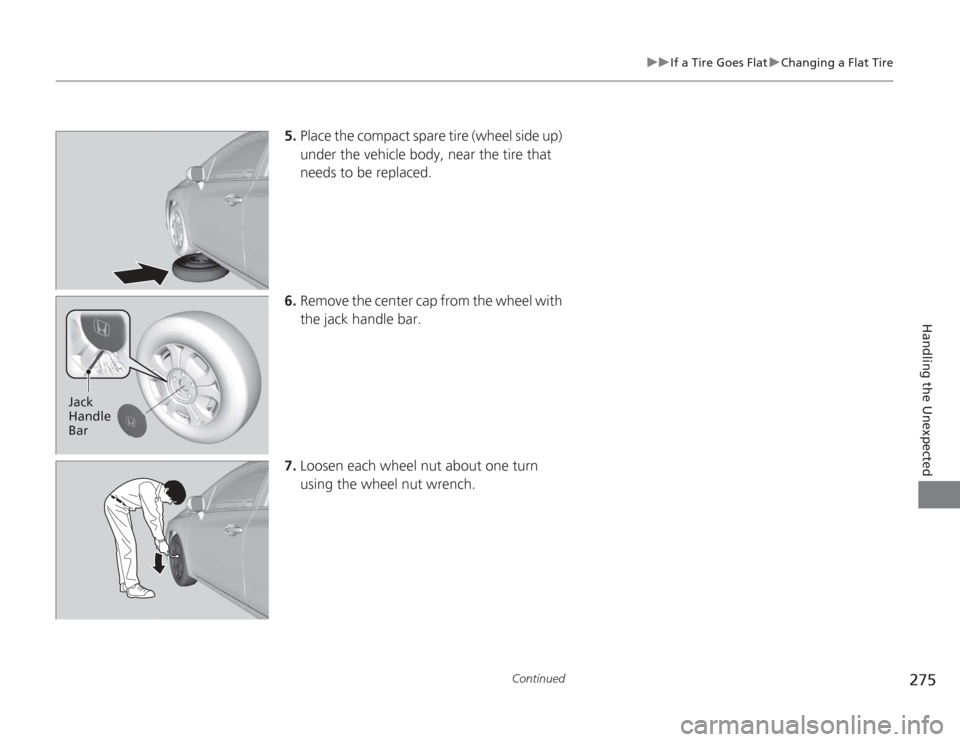
275
uuIf a Tire Goes Flat uChanging a Flat Tire
Continued
Handling the Unexpected
5. Place the compact spare tire (wheel side up)
under the vehicle body, near the tire that
needs to be replaced.
6. Remove the center cap from the wheel with
the jack handle bar.
7. Loosen each wheel nut about one turn
using the wheel nut wrench.
Jack
Handle
Bar
Page 278 of 313
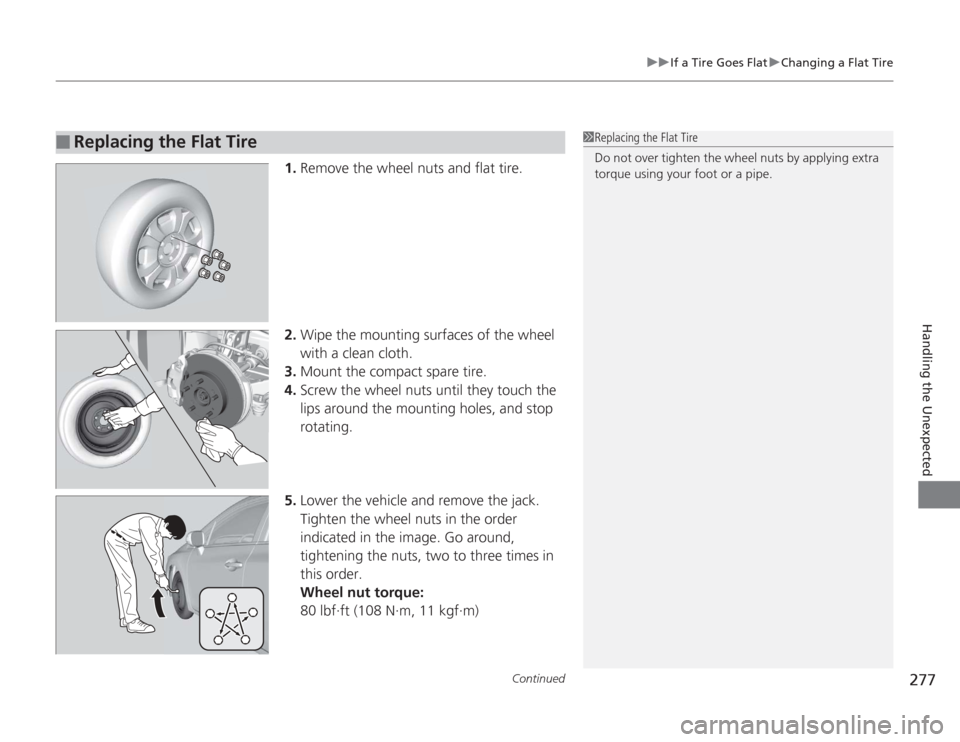
Continued
277
uuIf a Tire Goes Flat uChanging a Flat Tire
Handling the Unexpected
1. Remove the wheel nuts and flat tire.
2. Wipe the mounting surfaces of the wheel
with a clean cloth.
3. Mount the compact spare tire.
4. Screw the wheel nuts until they touch the
lips around the mounting holes, and stop
rotating.
5. Lower the vehicle and remove the jack.
Tighten the wheel nuts in the order
indicated in the image. Go around,
tightening the nuts, two to three times in
this order.
Wheel nut torque:
80 lbf∙ft (108 N∙m, 11 kgf∙m)
■
Replacing the Flat Tire
1Replacing the Flat Tire
Do not over tighten the wheel nuts by applying extra
torque using your foot or a pipe.
Page 279 of 313
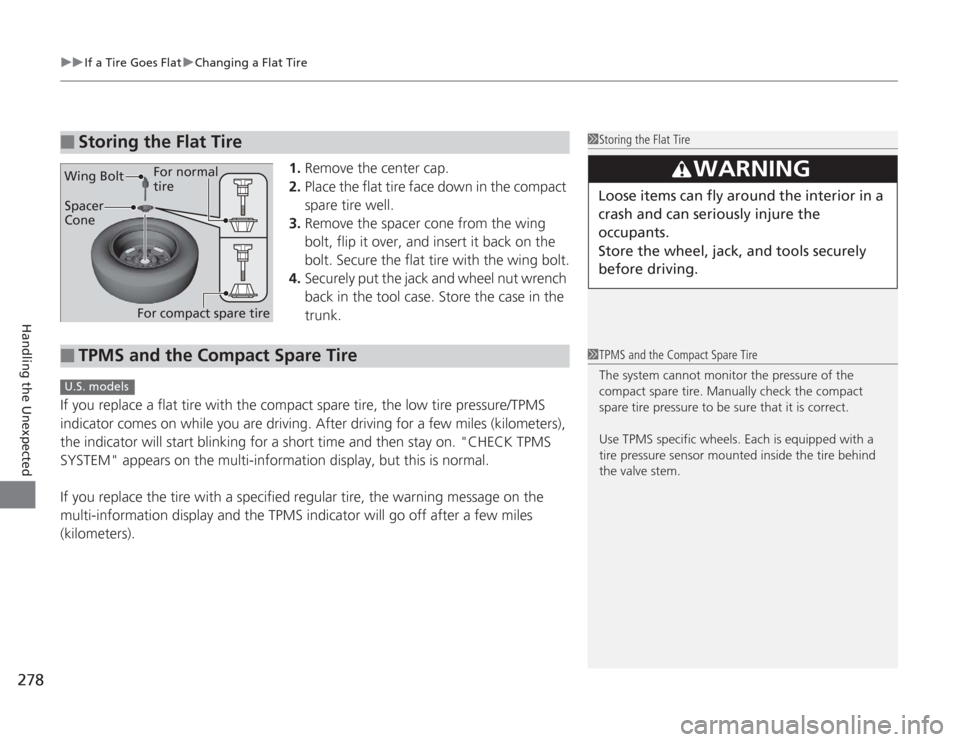
uuIf a Tire Goes Flat uChanging a Flat Tire
278Handling the Unexpected
1. Remove the center cap.
2. Place the flat tire face down in the compact
spare tire well.
3. Remove the spacer cone from the wing
bolt, flip it over, and insert it back on the
bolt. Secure the flat tire with the wing bolt.
4. Securely put the jack and wheel nut wrench
back in the tool case. Store the case in the
trunk.
If you replace a flat tire with the compact spare tire, the low tire pressure/TPMS
indicator comes on while you are driving. After driving for a few miles (kilometers),
the indicator will start blinking for a short time and then stay on. "CHECK TPMS
SYSTEM" appears on the multi-information display, but this is normal.
If you replace the tire with a specified regular tire, the warning message on the
multi-information display and the TPMS indicator will go off after a few miles
(kilometers).
■
Storing the Flat Tire
1 Storing the Flat Tire
3
WARNING
Loose items can fly around the interior in a
crash and can seriously injure the
occupants.
Store the wheel, jack, and tools securely
before driving.
Spacer
Cone
Wing Bolt
For compact spare tire For normal
tire
■
TPMS and the Compact Spare Tire
1
TPMS and the Compact Spare Tire
The system cannot monitor the pressure of the
compact spare tire. Manually check the compact
spare tire pressure to be sure that it is correct.
Use TPMS specific wheels. Each is equipped with a
tire pressure sensor mounted inside the tire behind
the valve stem.
U.S. models
Page 296 of 313
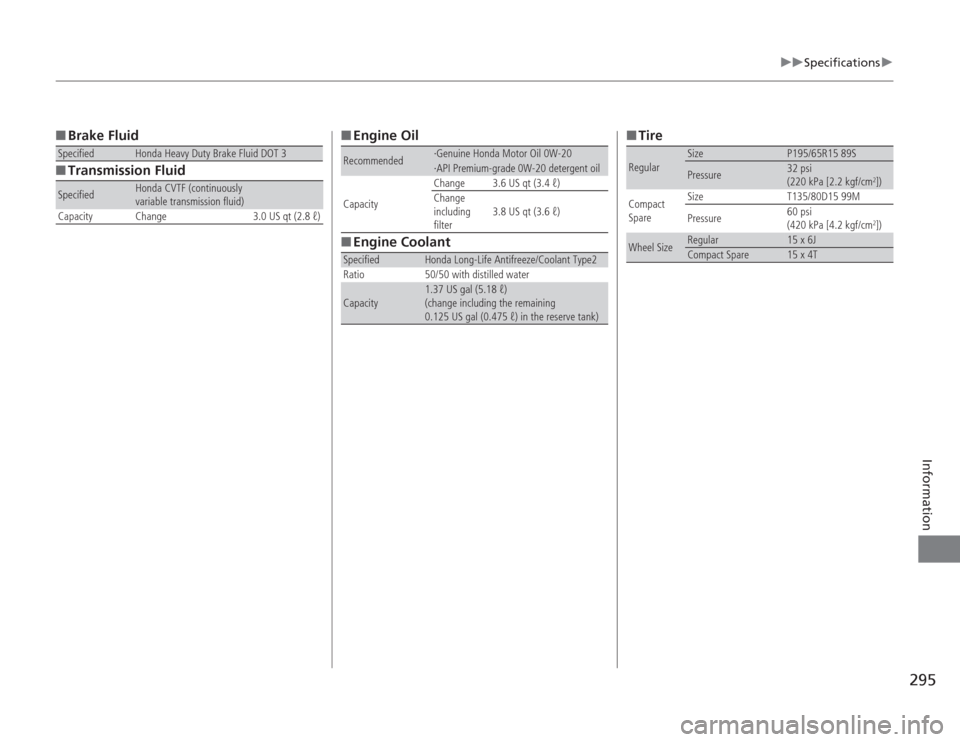
295
uuSpecifications u
Information
■Brake Fluid
■ Transmission FluidSpecified
Honda Heavy Duty Brake Fluid DOT 3
Specified
Honda CVTF (continuously
variable transmission fluid)
Capacity Change 3.0 US qt (2.8 ℓ)
■Engine Oil
■ Engine CoolantRecommended
·Genuine Honda Motor Oil 0W-20·API Premium-grade 0W-20 detergent oil
Capacity Change 3.6 US qt (3.4 ℓ)
Change
including
filter
3.8 US qt (3.6 ℓ)
Specified
Honda Long-Life Antifreeze/Coolant Type2
Ratio 50/50 with distilled water
Capacity
1.37 US gal (5.18 ℓ)
(change including the remaining
0.125 US gal (0.475 ℓ) in the reserve tank)
■ TireRegular
Size
P195/65R15 89S
Pressure
32 psi
(220 kPa [2.2 kgf/cm
2])
Compact
Spare Size
T135/80D15 99M
Pressure 60 psi
(420 kPa [4.2 kgf/cm2])
Wheel Size
Regular
15 x 6J
Compact Spare
15 x 4T
Page 312 of 313

311
INDEX
Spare Tire......................................... 273, 295
Spark Plugs ............................................... 294
Specifications ........................................... 294
Specified Fuel ................................... 222, 294
Speedometer .............................................. 82
SRS Airbags (Airbags) ................................ 39
Starting the Engine .................................. 198
Does Not Start ........................................ 279
Engine Switch Buzzer .............................. 117
Jump Starting ......................................... 280
Steering Wheel ........................................ 124
Adjusting ................................................ 124
Stopping ................................................... 217
Supplemental Restraint System (SRS) ....... 42
Switches (Around the Steering Wheel) ............................................ 2, 3, 117
System Message Indicator ......................... 76TTachometer................................................ 82
Temperature High Temperature Indicator ...................... 78
Low Temperature Indicator ....................... 78
Outside Temperature Display .................... 86
Temperature Sensor .................................. 86
Time (Setting) ........................................... 102
Tire Pressure Monitoring System (TPMS) ..................................................... 210
Indicator ........................................... 75, 288
Tires .......................................................... 254 Air Pressure ..................................... 255, 295
Checking and Maintaining ....................... 254
Compact Spare Tire ......................... 273, 295
Inspection ................................................ 254
Labeling .................................................. 255
Puncture (Flat Tire) ................................... 273
Regulations ............................................. 257
Rotation .................................................. 261
Tire Chains .............................................. 262
Wear Indicators ....................................... 259
Winter ..................................................... 262
Tools .......................................................... 272
Towing a Trailer ....................................... 197
Towing Your Vehicle ................................ 197
Emergency .............................................. 292
TPMS (Tire Pressure Monitoring System) .................................................... 210
Indicator ............................................ 75, 288
Transmission ............................................. 203
Automatic ............................................... 203
Fluid ........................................................ 244
Number ................................................... 296
Shift Lever Position Indicator .............. 71, 204
Trip Meter ................................................... 84
Troubleshooting ....................................... 271
Blown Fuse ...................................... 289, 290
Brake Pedal Vibrates .................................. 23
Buzzer Sounds When Opening Door .......... 23
Emergency Towing .................................. 292
Engine Does Not Start ............................. 279
Noise When Braking .................................. 23 Overheating ............................................ 283
Puncture/Flat Tire .................................... 273
Rear Door Won’t Open...................... 22, 108
Regular Gasoline ............................. 222, 294
Shift Lever Won’t Move ........................... 282
Warning Indicators .................................... 70
Trunk ......................................................... 110
Lid........................................................... 110
Light Bulb................................................ 294
Turn Signals .............................................. 118
Indicators (Instrument Panel) ..................... 76
UUnlocking the Doors ................................ 105
Unlocking the Front Doors from the
Inside ......................................................... 15
USB Adapter Cable ................................... 143
USB Flash Drives ....................................... 166VValet Key................................................... 104
Vanity Mirrors ............................................... 5
Vehicle Identification Number ................ 296
Vehicle Stability Assist (VSA
®) .................. 208
Off Button............................................... 209
Off Indicator.............................................. 74
System Indicator ........................................ 73
Viscosity (Oil) .................................... 237, 295
VSA
® (Vehicle Stability Assist) .................. 208